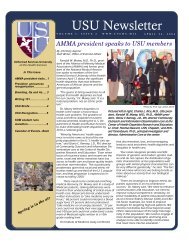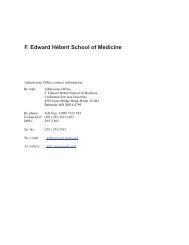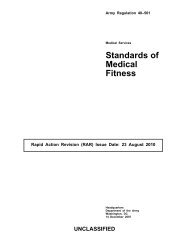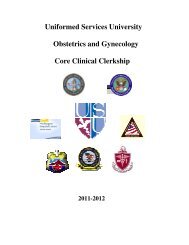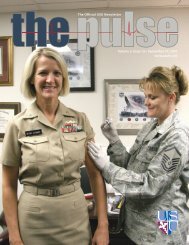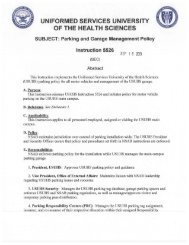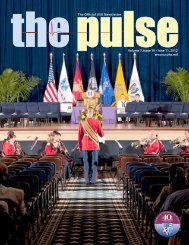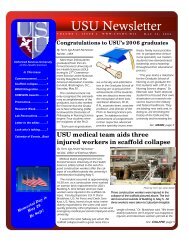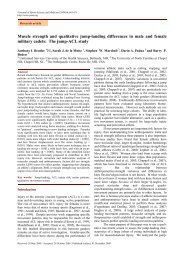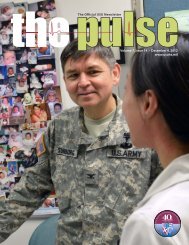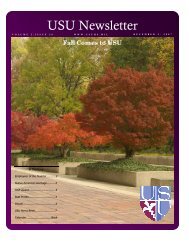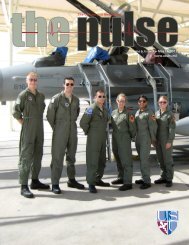CourageCenter for Disaster and Humanitarian ResponseThe U.S. military is increasingly called on to supportdomestic and international disaster response ando<strong>the</strong>r humanitarian assistance efforts, which <strong>of</strong>teninvolves providing medical care in austere environmentsand in developing countries. The Center forDisaster and Humanitarian Assistance Medicine(CDHAM), which operates within USU’s Department<strong>of</strong> Military and Emergency Medicine, serves as acentral resource for <strong>the</strong> DoD, o<strong>the</strong>r government agenciesand international partners.Headed by Robert Darling, M.D., a graduate <strong>of</strong> <strong>the</strong>USU class <strong>of</strong> 1985, CDHAM’s staff has expertisein a broad range <strong>of</strong> areas, and its academic settingenables a multidisciplinary approach to disastermitigation. The program is engaged in a full range<strong>of</strong> initiatives aimed at improving preparedness andresponse. Many <strong>of</strong> <strong>the</strong>se efforts are undertaken withforeign military and civilian agencies, as well as o<strong>the</strong>rleading U.S. academic medical centers.The center supports <strong>the</strong> U.S. military with a widerange <strong>of</strong> health-related activities around <strong>the</strong> world.CDHAM works with <strong>the</strong> Global Emerging InfectionsSurveillance and Response System (DoD-GEIS)on a pandemic influenza program, serving as aresource for commanders in <strong>the</strong> field. The center iscollaborating with <strong>the</strong> U.S. Sou<strong>the</strong>rn Command tocreate a sustainable HIV/AIDS prevention programfor Caribbean defense forces in seven countries.Staff members also are working with <strong>the</strong> government<strong>of</strong> Chad on a landmine assistance program to helpgovernment and military forces provide care to victims<strong>of</strong> landmines.In May <strong>of</strong> 2007, two researchers with CDHAMpublished a study showing that many residents <strong>of</strong>FEMA-created trailer parks housing persons displacedby Hurricane Katrina are facing serious and persistentmental health issues. According to <strong>the</strong> study, whichappeared in <strong>the</strong> Annals <strong>of</strong> Emergency Medicine,major depression is a pervasive problem, with suicideattempts among trailer park residents at a rate 78times higher than <strong>the</strong> national average. The researchers,Lynn Lawry, M.D. and Michael P. Anastario, Ph.D.,used a global humanitarian aid perspective to assessa number <strong>of</strong> factors, including mental health, for <strong>the</strong>purpose <strong>of</strong> informing recovery efforts.In 2007, a CDHAM team traveled to Afghanistan tohelp coordinate efforts to devise strategies to createa long-term health care infrastructure by helping torebuild <strong>the</strong> civilian medical system and expandinghealth care expertise within <strong>the</strong> country. Efforts includeworking with Afghan National Security Forces tohelp <strong>the</strong>m develop <strong>the</strong>ir health care infrastructure andconduct health care training programs.The Center’s staff has expertise in abroad range <strong>of</strong> areas, and its academicsetting enables a multidisciplinaryapproach to disaster mitigation.Jim Holliman, M.D., was part <strong>of</strong> a CDHAMteam that travelled to Afghanistan.30
National Capital Area Medical Simulation CenterThe National Capital Area Medical SimulationCenter houses some <strong>of</strong> <strong>the</strong> most advancedmedical simulation technologies in <strong>the</strong> world. At<strong>the</strong> Simulation Center, students undertake criticalclinical and surgical skills training, including takingpart in exercises involving live simulated patients,high-fidelity patient mannequins and virtual realitycomputer-enhanced task trainers. The center conductsroughly 8,000 simulations each academicyear, and its resources are available to all universitymedical and nursing students, interns, residents ando<strong>the</strong>rs in <strong>the</strong> USU community.Immersive Virtual EnviaronmentThe center is home to a cutting-edge Wide AreaVirtual Environment (WAVE). Most computer-basedmedical simulators focus on individual training,but in reality, most medical care is administered inteams. The WAVE creates a realistic environmentin which groups <strong>of</strong> students can train toge<strong>the</strong>r tocare for <strong>the</strong> injured during combat situations. Theinitial prototype system creates a 3-D environment,complete with an advanced sound system, thatimmerses participants in a battlefield setting. TheWAVE also can be used to simulate disaster,biological attack and o<strong>the</strong>r mass casualtyscenarios. It is one <strong>of</strong> <strong>the</strong> only facilities <strong>of</strong> itskind in <strong>the</strong> world.Surgical SimulationThe center’s Surgical Simulation Laboratoryincludes a full-scale operating room, as well as avirtual reality room, which provide realistic scenariosfor trauma and surgical training. The operatingroom is equipped with computerized, high-fidelityhuman patient mannequins, and <strong>the</strong> virtual realityroom houses computer-enhanced task trainers thatenable students to practice surgical procedures,endoscopic skills and laparoscopic techniques.Clinical SkillsThe Simulation Center’s Clinical Skills TeachingLaboratory includes 12 patient examination roomswhere standardized patients, played by actors,help students hone <strong>the</strong>ir communication, interpersonal,pr<strong>of</strong>essional, physical exam and diagnosticreasoning skills. Faculty monitor <strong>the</strong> encounters andprovide students with critical feedback.The Simulation Centeruses state-<strong>of</strong>-<strong>the</strong>-arttechnologies to conductspecialized clinical andsurgical skills training. Bygraduation, USU studentswill have taken part inroughly 40 differentsimulations.31




